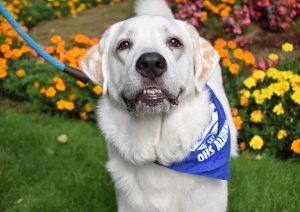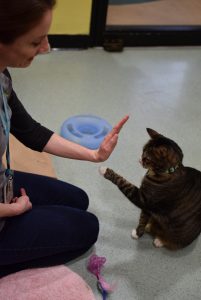Make a resolution to master some pet behavior basics in 2020.
It’s a new year and a great opportunity to strengthen your relationship with your pet. One of the best ways to solidify your bond with your four-legged family member is through positive learning experiences. This can be as simple as scheduling playtime, adding some pet-friendly elements to your home or teaching your cat or dog a new trick.
While you may be making your own resolutions to get healthier, save money or master a new skill, don’t forget to make sure your pet has opportunities to thrive in 2020.
Here are the top 5 things every cat and dog owner needs to do for their pet in 2020.
 For dogs:
For dogs:
- Leashing up – Putting your dog’s leash on before going for a walk shouldn’t resemble a game of ping pong. If your dog gets so excited that they are bouncing around and difficult to leash, it’s time to work on teaching them to sit or stand calmly so they can be easily leashed up before a walk. This can take a lot of patience and trial and error, but it’s worth mastering in 2020.
- Wait – The saying “good things come to those who wait” is certainly true for our dogs. Teaching your dog the “wait” cue can also be a matter of safety. The wait cue can be used before going through doors, getting in or out of the car, or eating dinner.
- Come – There are few things that are more frustrating than having your dog not come to you when you call them. Dogs need to be taught this cue the right way for it to become rock-solid in their skill set. Build your dog’s recall by only calling them for good things (not bath time or nail trims). Reward them with praise and their favorite treat. In addition to coming when their name is called, you can also teach your dog to come to a whistle or squeaker.
- Visitor etiquette – When the doorbell rings or there’s a knock on the door, does your dog bark and jump around? Does your dog greet visitors with unending enthusiasm? You can teach your dog to go to their bed or get a toy when people come to the door. This invaluable skill takes work, but with consistency and practice, your dog can master it in 2020.
- Chill out – Teaching your dog to be calm and providing quiet time is just as important as exercise and activity. Make sure your dog has opportunities to rest and practice being calm.
For cats:
- Teaching tricks – Contrary to popular belief, you can teach a cat new tricks. Teaching your cat tricks is a great way to bond with them and provide mental stimulation. This year, try teaching your cat to high-five. Hold a treat in your hand, wait for your cat to paw your hand, say “yes,” and then give them the treat. Repeat a few times, then try holding up your hand without a treat in it. As soon as your cat touches their paw to your hand, say ‘yes’ and treat. Keep sessions short and end on a success.
- Carrier acceptance – Help your cat reduce their fear of the carrier by leaving it out all the time and giving them a chance to use it as a perch or hiding place. The more familiar your cat is with their carrier, the easier it will be to put them in it next time you need to go to the vet.
- Know your cat’s style – Does your cat love to hang out on top of your refrigerator, or would they rather stay on the ground, under your bed? Whatever their style, make sure you provide opportunities for them to be themselves. This year, consider hanging shelves and perches specifically for your cats or providing cozy beds in easy-to-access hiding spots.
- The Golden Rule of litter boxes – Resolve to scoop your cat’s litter box at least once a day. You should also consider having one box per cat, plus one more, in your home. This will help ensure your cat always goes in the right place.
- Interactive playtime – Don’t just give your cat toys to play with. Schedule 10-20 minutes per day to actively engage with them. The cat dancer or other lure toys will help your cat practice their natural behavior and get exercise. Your cat will thank you for it with purrs and snuggles.
Questions about pet training and behavior? Call our free pet behavior help line at (503) 416-2983.
 Tanya Roberts is the Senior Manager of the OHS Training & Behavior Department and a Certified Professional Dog Trainer (CPDT-KA). Tanya continues her education by attending seminars and trainings so she can provide clients with current, scientifically-based information. Her best teachers continue to be the wonderful animals at the Oregon Humane Society, who she works with regularly during their stay.
Tanya Roberts is the Senior Manager of the OHS Training & Behavior Department and a Certified Professional Dog Trainer (CPDT-KA). Tanya continues her education by attending seminars and trainings so she can provide clients with current, scientifically-based information. Her best teachers continue to be the wonderful animals at the Oregon Humane Society, who she works with regularly during their stay.





